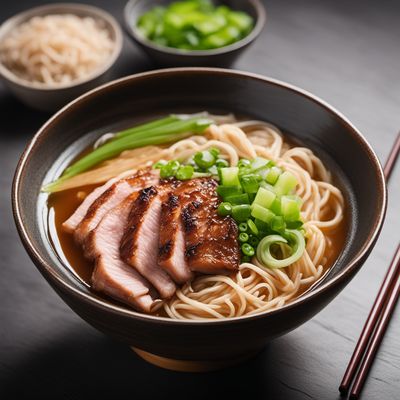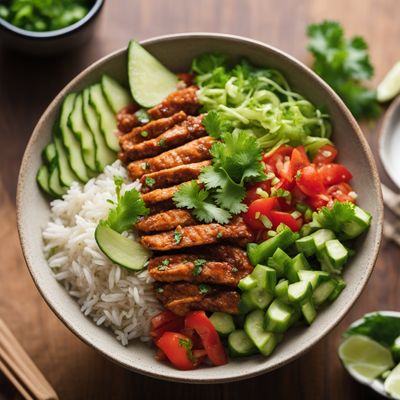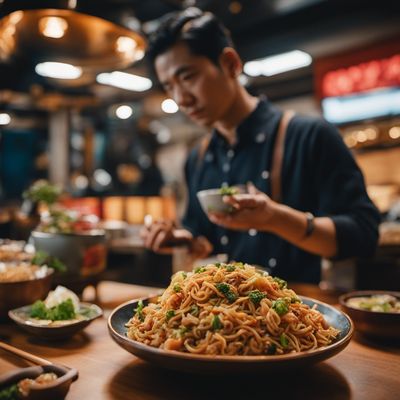
Recipe
Xinjiang-style Spicy Wakame Udon
Fiery Fusion: Xinjiang Spiced Wakame Udon
4.4 out of 5
Indulge in the bold flavors of Xinjiang cuisine with this tantalizing recipe for Spicy Wakame Udon. Combining the delicate essence of Japanese udon noodles with the fiery spices of Xinjiang, this dish is a fusion of cultures that will ignite your taste buds.
Metadata
Preparation time
15 minutes
Cooking time
10 minutes
Total time
25 minutes
Yields
4 servings
Preparation difficulty
Easy
Suitable for
Vegetarian, Vegan, Dairy-free, Nut-free, Low calorie
Allergens
Soy, Wheat
Not suitable for
Gluten-free, Paleo, Keto, High protein, Low carb
Ingredients
In this Xinjiang adaptation of the original Japanese dish, we incorporate the bold and spicy flavors that are synonymous with Xinjiang cuisine. The original dish is typically milder in taste, while the Xinjiang version adds a fiery kick to the udon noodles. Additionally, we introduce Xinjiang spices and ingredients to enhance the flavor profile and create a unique fusion experience. We alse have the original recipe for Wakame udon, so you can check it out.
-
250g (8.8 oz) udon noodles 250g (8.8 oz) udon noodles
-
2 tablespoons vegetable oil 2 tablespoons vegetable oil
-
1 onion, thinly sliced 1 onion, thinly sliced
-
2 cloves garlic, minced 2 cloves garlic, minced
-
1 red bell pepper, thinly sliced 1 red bell pepper, thinly sliced
-
1 carrot, julienned 1 carrot, julienned
-
200g (7 oz) wakame seaweed, rehydrated and drained 200g (7 oz) wakame seaweed, rehydrated and drained
-
2 tablespoons soy sauce 2 tablespoons soy sauce
-
1 tablespoon chili bean paste 1 tablespoon chili bean paste
-
1 teaspoon cumin powder 1 teaspoon cumin powder
-
1 teaspoon Sichuan peppercorns, crushed 1 teaspoon Sichuan peppercorns, crushed
-
1 teaspoon sugar 1 teaspoon sugar
-
Salt, to taste Salt, to taste
-
Fresh cilantro, for garnish Fresh cilantro, for garnish
Nutrition
- Calories (kcal / KJ): 320 kcal / 1340 KJ
- Fat (total, saturated): 8g, 1g
- Carbohydrates (total, sugars): 55g, 8g
- Protein: 10g
- Fiber: 6g
- Salt: 2g
Preparation
-
1.Cook the udon noodles according to the package instructions. Drain and set aside.
-
2.Heat the vegetable oil in a large pan or wok over medium heat.
-
3.Add the sliced onion and minced garlic to the pan and sauté until fragrant and slightly softened.
-
4.Add the red bell pepper and carrot to the pan and stir-fry for a few minutes until they begin to soften.
-
5.In a small bowl, mix together the soy sauce, chili bean paste, cumin powder, crushed Sichuan peppercorns, sugar, and salt.
-
6.Pour the sauce mixture into the pan and stir well to coat the vegetables.
-
7.Add the rehydrated wakame seaweed to the pan and stir-fry for another minute.
-
8.Finally, add the cooked udon noodles to the pan and toss gently to combine all the ingredients and evenly coat the noodles with the sauce.
-
9.Cook for an additional 2-3 minutes until the noodles are heated through.
-
10.Serve the Xinjiang-style Spicy Wakame Udon hot, garnished with fresh cilantro.
Treat your ingredients with care...
- Udon noodles — Cook the udon noodles according to the package instructions, but make sure to slightly undercook them as they will continue to cook when stir-fried with the other ingredients.
- Wakame seaweed — Rehydrate the wakame seaweed in cold water for about 5 minutes until it becomes soft and pliable. Drain well before adding it to the dish.
Tips & Tricks
- For an extra spicy kick, add a few slices of fresh chili pepper or a dash of chili oil to the dish.
- Customize the vegetables according to your preference. You can add mushrooms, snow peas, or any other vegetables you enjoy.
- If you prefer a milder flavor, reduce the amount of chili bean paste and Sichuan peppercorns.
- To make it heartier, you can add some protein such as tofu, tempeh, or seitan to the dish.
- Leftovers can be stored in an airtight container in the refrigerator for up to 2 days.
Serving advice
Serve the Xinjiang-style Spicy Wakame Udon as a main course, accompanied by a fresh salad or steamed vegetables. It can also be enjoyed as a side dish alongside other Xinjiang-inspired dishes.
Presentation advice
Garnish the dish with a sprinkle of crushed Sichuan peppercorns and a few fresh cilantro leaves to add a pop of color and enhance the visual appeal. Serve it in a vibrant bowl to showcase the beautiful red sauce.
More recipes...
For Wakame udon
For Japanese cuisine » Browse all

Homemade Hakata Ramen
Savory Delights: Homemade Hakata Ramen - A Bowl of Japanese Comfort

Hanetsuki Mochi - Traditional Japanese New Year's Treat
Fluffy Delights: Hanetsuki Mochi - A Sweet Celebration of Japanese New Year

Takoraisu - Japanese-Inspired Rice and Taco Bowl
Tokyo Taco Bowl: A Fusion of Japanese and Mexican Flavors
More Japanese cuisine dishes » Browse all

Negitorodon
Negitorodon is a traditional Japanese dish that consists of raw tuna and green onions served over a bed of rice.

Uni chawanmushi
Japanese egg custard with sea urchin
Uni chawanmushi is a Japanese dish made with steamed egg custard and sea urchin. It is a delicate and flavorful dish that is often served as an...

Yakisoba
Yakisoba is a Japanese noodle dish that is made with stir-fried noodles, vegetables, and meat or seafood.





